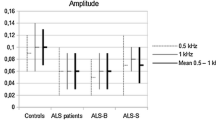Summary
The decay and recovery of stapedial reflex amplitude was investigated in 19 patients with myasthenia gravis and 30 control subjects. In 9 untreated patients the amplitude was reduced to less than 10% of the initial amplitude following continuous stimulation for 120 s, whereas the maximum decay in the control subjects was only 50%. In the group of treated patients the reflex decay showed individual variations. The rate of recovery after prolonged stimulation (5 min) was slower in the patient group, especially within the first 30 s of recovery. With increasing age, the rate of decay rose in the patient group as well as in the control group. The technical parameters necessary for obtaining information of clear diagnostic value are indicated, with which it was shown that the continuous prolonged stimulation of the stapedial muscle is a practical and valid method for the evaluation of patients with myasthenia gravis.
Similar content being viewed by others
References
Ahuja GK, Verma A, Ghosh P, Nagaraj MN (1980) Stapedius reflexometry. A diagnostic test of myasthenia gravis. J Neurol Sci 46:311–314
Anderson H, Barr B, Wedenberg E (1970) Early diagnosis of VIIIth-nerve tumours by acoustic reflex tests. Acta Otolaryngol (Stockh) 263:232–237
Blom S, Zakrisson JE (1974) The stapedius reflex in the diagnosis of myasthenia gravis. J Neurol Sci 21:71–76
Borg E (1973) On the neuronal organisation of the acoustic middle ear reflex. A physiological and anatomical study. Brain 49:101–123
Borg E, Ödman B (1979) Decay and recovery of the acoustic stapedial reflex in humans. Acta Otolaryngol (Sockh) 87:421–428
Citron D, Adour KK (1978) Acoustic reflex and loudness discomfort in acute facial paralysis. Arch Otolaryngol 104:303–306
Desmedt JE (1973) The neuromuscular disorders in myasthenia gravis. 1. Electrical and mechanical response to nerve stimulation in hand muscles. In: Desmedt JE (ed) New developments in electromyography and clinical neurophysiology, vol 1. Karger, Basel, pp 241–304
Eaton L, Lambert EH (1957) Electromyography and electric stimulation of nerves in diseases of motor unit. JAMA:1117–1124
Ekstrand T, Glitterstam K (1979) Bell's palsy—prognostic value of the stapedius reflex with contralateral stimulation. J Laryngol Otol 93:271–275
Habener SA, Snyder JM (1974) Stapedius reflex amplitude and decay in normal hearing ears. Arch Otolaryngol 100:294–297
Hall JW (1982) Acoustic reflex amplitude. I. Effect of age and sex. Audiology 21:294–309
Hirsch A (1983) The stapedius reflex tests in retrocochlear hearing disorders. Audiology 22:463–470
Johns RJ, Grob D, Harvey AM (1956) Studies in neuromuscular function. II. Effects of nerve stimulation in normal subjects and in patients with myasthenia gravis. Bull Johns Hopkins Hosp 99:125–135
Kimura J (1983) Electrodiagnosis in diseases of nerve and muscle. Davis, Philadelphia
Kramer LD, Ruth RA, Johns ME, Sanders DB (1981) A comparison of stapedial reflex fatigue with repetitive stimulation and singlefiber EMG in myasthenia gravis. Ann Neurol 9:531–536
Laurian N, Laurian R, Sadov R, Strauss M, Kalmanovitz M (1983) New clinical applications of the stapedial reflex. J Laryngol Otol 91:1099–1103
Morioka WT, Neff PA, Boisseranc TE, Hartmann PW, Cantrell RW (1976) Audiotympanometric findings in myasthenia gravis. Arch Otolaryngol 102:211–213
Nilsson R, Borg E, Liden G (1980) Fatigability of the stapedius reflex in industrial noise. Acta Otolaryngol (Stockh) 89:433–439
Osserman KE (1958) Myasthenia gravis. Grune and Straton, New York
Rosenhall U, Liden G, Nilsson E (1979) Stapedius reflex decay in normal hearing subjects. J Am Aud Soc 4:157–163
Ruth RA, Johns ME, Gal TF (1980) Acoustic reflex responses during curare-induced weakness. Ann Otol 89:188–193
Sanders A (1987) The electrodiagnosis of myasthenia gravis. Ann NY Acad Sci 505:539–556
Shanks JE, Lilly DJ, Margolis RH, Wiley TL, Wilson RH (1988) Tympanometry-ASHA working group on aural acoustic-immitance measurements committee on audiologic evaluation. J Speech Hear Dis 53:354–377
Silman S, Silverman CA, Gelford AG, Lutolf J, Lynn DL (1988) Ipsilateral acoustic-reflex adaptation testing for detection of facialnerve palsy. J Speech Hear Dis 53:378–382
Stalberg E (1979) Neuromuscular transmission studied with single fibre electromyography. Acta Scand Anaesth [Suppl] 70:112–124
Warren WR, Gutmann L, Cody RC, Flowers P, Segal AT (1977) Stapedius reflex decay in myasthenia gravis. Arch Neurol 34:496–497
Yamane M, Nomura Y (1984) Analysis of stapedial reflex in neuromuscular diseases. ORL 46:84–96
Young E, Sachs MB (1973) Recovery from sound exposure in auditory nerve fibres. J Acoust Soc Am 53:1535
Author information
Authors and Affiliations
Rights and permissions
About this article
Cite this article
Bischoff, C., Klingelhöfer, J. & Conrad, B. Decay and recovery of the stapedial reflex by prolonged stimulation in the diagnosis of myasthenia gravis. J Neurol 236, 343–348 (1989). https://doi.org/10.1007/BF00314377
Received:
Revised:
Accepted:
Issue Date:
DOI: https://doi.org/10.1007/BF00314377



